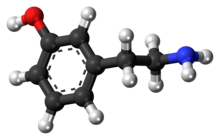 | |
 | |
| Names | |
|---|---|
| Preferred IUPAC name 3-(2-Aminoethyl)phenol | |
| Other names m-Tyramine; 3-Tyramine; 3-Hydroxyphenethylamine; 3-Hydroxyphenylethylamine; 3-OH-PEA | |
| Identifiers | |
3D model (JSmol) | |
| ChEBI | |
| ChemSpider | |
| ECHA InfoCard | 100.197.155 |
PubChem CID | |
| UNII | |
CompTox Dashboard (EPA) | |
| |
| |
| Properties | |
| C8H11NO | |
| Molar mass | 137.182 g·mol−1 |
Except where otherwise noted, data are given for materials in their standard state (at 25 °C [77 °F], 100 kPa). | |
meta-Tyramine, also known as m-tyramine and 3-tyramine, as well as 3-hydroxyphenethylamine, is an endogenous trace amine neuromodulator and a structural analog of phenethylamine. [1] [2] [3] It is a positional isomer of para-tyramine, and similarly to it, has effects on the adrenergic and dopaminergic systems. [4] [5]
meta-Tyramine is produced in humans via aromatic amino acid decarboxylase-mediated metabolism of meta-tyrosine. [6] meta-Tyramine can be metabolized into dopamine via peripheral or brain CYP2D6 enzymes in humans. [7]